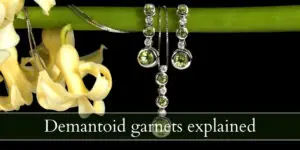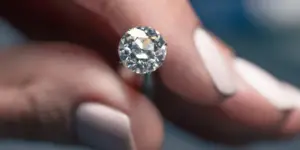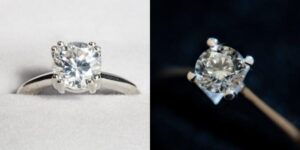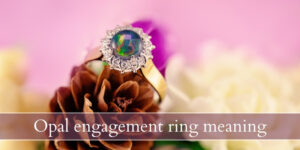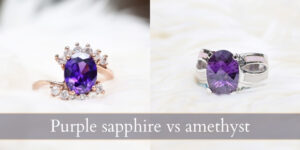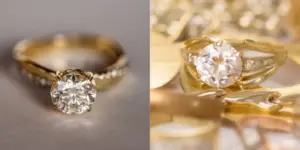Fancy color diamonds may sound confusing at first, but in truth they’re more common than you think. These colorful beauties have been the center stone for quite a few famous engagement rings, and they could also be yours !
So let’s talk fancy diamonds, what fancy colored diamonds are, whether they’re real diamonds or not, how expensive they get, and other options you can look at.
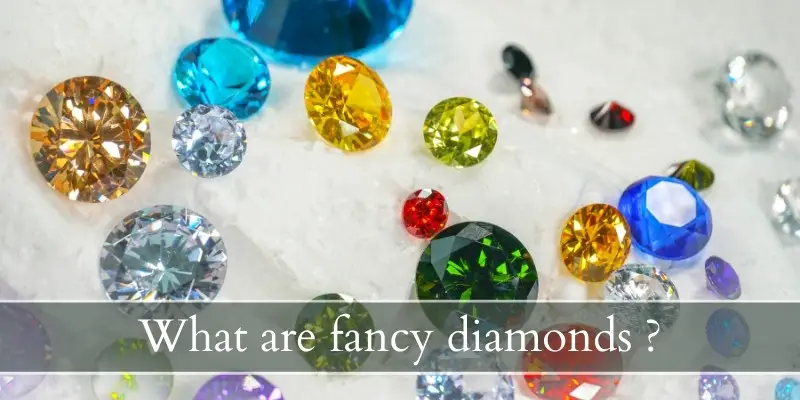
What are fancy color diamonds ?
Fancy color diamonds are simply diamonds that are not white or clear, so they show a definite color such as red, pink, blue, purple, yellow, and so on. Most diamonds on the market are clear (white) diamonds, and that is the offer because those are the pure, perfect, ideal diamonds.
The reason they’re called fancy color diamonds is to differentiate them from the clear white ones. The term ‘fancy” is a very old one, but is still used to this day in by reputed systems such as GIA.
There are also fancy cut diamonds, in regard to other cuts than round brilliant but these are less known. Usually when someone says they’re looking for a fancy diamond, they mean a colored diamond, not necessarily a differently cut diamond.
What is the real color of a diamond ?
All diamonds come with a bit of a tint to them, and the most common is the white to yellow tint. Very few diamonds appear colorless to the naked eye, and those will be graded D, E, or F (at least by GIA and IGI). Any other grade than that will have a slight yellow tinge.
So in fact white diamonds are not truly white. They appear white because of the way they are cut, but are in fact colorless. A diamond is graded by the four Cs:
- cut – how well the diamond is cut, looking at the table, culet, girdle, and angle alignments
- color – a combination of hue and intensity, with the complete lack of both marked as most desirable
- clarity – whether there are any inclusions or impurities within the crystal
- carat – size of the diamond, usually measured by weight, where 1 carat is 0.200 grams
So a white diamond, what you usually see in diamond jewelry and diamond engagement rings, is simply a diamond that has the highest color grade (D-F). A diamond’s clarity also affects its color in a way, since sometimes the inclusions may make the diamond appear a certain color when turned in some angles.
So a perfectly clear diamond – flawless to internally flawless – will not have anything to distort the light waves and return a different color to your eyes.
Read also: Bow Tie Effect In Diamonds
Can you treat a diamond to change color ?
Yes, diamonds can be color treated via irradiation, or subjected to high pressure and high heat for a prolonged time. The resulting colors are believable, and these diamonds will always be cheaper than natural fancy diamonds. In fact most fancy color diamonds on the market are color treated diamonds, meaning they started out as pale yellow and ended up the color you see.
Radiation treatment results in yellow-orange and sometimes pink-red diamonds. This depends on the starting diamond’s color, such as blue-green.
High pressure and high temperature generally lighten colors and add a bit of clarity. The usual resulting color is yellow.
Low pressure and high temperature are generally used to make graphite form within tiny fractures, resulting in black diamonds.
Any combination of these three treatments will result in the other possible colors.
Are fancy diamonds real ?
Yes, fancy diamonds are real diamonds albeit rare ones. Fancy diamonds get their colors from trace amounts of other elements within them (usually nitrogen or boron), or from slight imperfection in the crystal lattice (the physical way the diamond is formed).
Such things alter the light waves as they enter the diamond, and make it appear various colors. For example red, pink, and some brown diamonds appear so because of a difference in the crystal lattice, not necessarily trace amounts of another element.
If you’d like proof of some very real fancy diamonds, why not look up the engagement rings of some very famous people you might’ve heard of ? Here’s a list of fancy diamond engagement rings some celebs wear or have worn:
- Scarlett Johansson’s 11ct champagne pear cut diamond
- Blake Lively’s light pink oval cut diamond, 12cts (assumed)
- Kelly Clarkson’s yellow canary radiant cut diamond
- Carrie Underwood’s 5ct round cut yellow diamond
- Jennifer Lopez’s 6.1ct radiant cut pink diamond (2002, Ben Affleck)
- Heidi Klum’s 10ct oval cut yellow diamond (2004, Seal)
So fancy diamond engagement rings are a thing. Perhaps just as much as regular white diamonds. If this all sparked an idea in your head, read on to find out about general price ranges and rarity.
Are fancy diamonds more expensive ?
Fancy diamonds are not usually more expensive than white diamonds, but they are at about the same level. The general rule is that the rarer the diamond’s color, the more expensive it is. So pure colorless diamonds are the most expensive, as they are also graded for clarity stricter than colored diamonds. Of the colored diamonds, red and blue are the most expensive, with canary yellow and chocolate retailing for less.
You can also find grey diamonds for sale, which are about half the price of colorless diamonds, and milky white diamonds for half the price of a grey diamond. People always want their diamonds to sparkle, regardless of their color, so a more included diamond will always be cheaper.
Alternatives to fancy color diamonds
Fancy color diamonds are colorful, sparkly, and pretty expensive. And maybe you’d like something a bit more affordable ? Or perhaps you’re thinking that if it’s not colorless, it shouldn’t be a diamond ? Thankfully there are quite a few options you have when you want to find an alternative for your fancy color diamond. Some may be cheaper, some may have better color, and you should take a look at this list to figure out the direction you want to go.
Lab-grown fancy diamonds are about 20% cheaper
If the high price point is the main problem, then consider buying lab-grown fancy diamonds. These are diamonds that have the same chemical makeup as natural fancy diamonds, except they are grown in a controlled environment and can achieve the color you want far easier.
As you know, lab-grown gems are far more affordable than natural gems. In the case of diamonds, the price does go down but doesn’t drop dramatically. Just enough to make a 1ct lab-grown diamond manageable.
Colored gemstones, with a compromise in sparkle
If your emphasis is on color, then you’re better off with a colored gemstone because you will have an easier time finding this or that particular shade. But you have to understand that you will lose a lot of sparkle. Colored gems are simply different, and will not be as brilliant and sparkly as a fancy colored diamond.
The few colored gems that have a bit of sparkle are insanely expensive, like Meghan Fox’s green emerald that somehow manages to keep up with its twin diamond. So, with less sparkly hopes, you can take a look at various gems you like. Depending on the color you want, you could look at different gems.
For example red can be ruby, garnet, spinel, tourmaline. Blue is a big range, from sapphires to aquamarines, to topaz, to tourmaline, to tanzanite. Purples can be amethysts, tourmaline, topaz and greens can be emeralds, peridots, tourmaline, amethysts (yes!) and even some sapphires. So figure out what color you’d like and start from there.
Moissanite or cubic zirconia, with great sparkle but less cost
And finally, we have the diamond simulants. Would they truly be diamond simulants if they couldn’t simulate fancy diamonds as well ? Of course not. So here you have two options, cubic zirconia and moissanite. Of the two moissanite is the more believable one, but CZ doesn’t fall very far behind.
We see only upsides to these two gems. They can:
- get you the right color and even exact shade
- bring a diamond-like fire and brilliance, even when colorful
- be quite affordable
Both moissanite and cubic zirconia are lab-grown, meaning they will always have reduced costs.

I’m the main author for jewelrymaterialguide.com. I started this site after we did tons of research before our wedding and noticed that there is information about rings, jewelry, and so on that is really hard to find on the internet.

